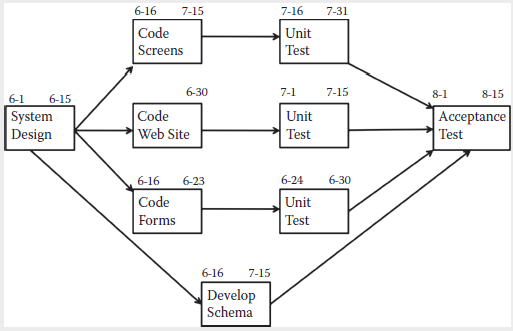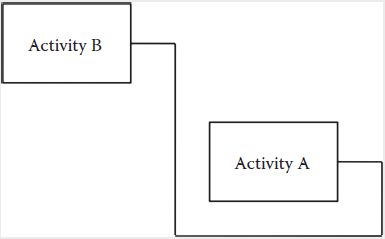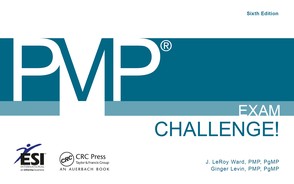Section 3
Project Time Management
Project Time Management comprises which seven major processes?
ANSWER
- Plan Schedule Management
- Define Activities
- Sequence Activities
- Estimate Activity Resources
- Estimate Activity Durations
- Develop Schedule
- Control Schedule
[Planning and Monitoring and Controlling]
2 QUESTION
Define total float.
ANSWER
The amount of time that an activity can be delayed from its early start without delaying the project end date or violating a schedule constraint.
[Planning]
Why is the key benefit of the plan schedule management process?
ANSWER
To provide guidance and direction on how the project schedule will be managed throughout the project
[Planning]
4 QUESTION
How are performance reviews used in control schedule?
ANSWER
As a tool and technique to measure, compare, and analyze schedule performance such as actual start and finish dates, percent complete, and remaining duration for work in progress
[Monitoring and Controlling]
What is included in the define activities process?
ANSWER
Identifying the specific actions to be performed in order to produce the project deliverables.
[Planning]
6 QUESTION
What are the four project documents that may need to be updated as an output of sequence activities?
ANSWER
- Activity lists
- Activity attributes
- Milestone list
- Risk register
[Planning]
Describe the relationship between the WBS and an activity list.
ANSWER
The activity list is developed from the identified work packages in the WBS.
[Planning]
8 QUESTION
What is another term used for the precedence diagramming method?
ANSWER
Activity-on-node.
[Planning]
What is the result of a critical path method (CPM) calculation?
ANSWER
Early and late start and finish dates for each activity based on a specified network logic and a single deterministic duration estimate. The focus is on calculating float to determine which activities have the least scheduling flexibility.
[Planning]
10 QUESTION
What is a planning package?
ANSWER
A component below the control account but above the work package that identifies project work that does not have detailed schedule activities.
[Planning]
What is included in sequence activities?
ANSWER
Identifying and documenting relationships among the project activities
[Planning]
12 QUESTION
What often happens as a result of resource leveling?
ANSWER
The original critical path will change.
[Planning]
Is elapsed time included when estimating required work periods?
ANSWER
Yes. For example, if “concrete curing” requires four days of elapsed time, it may require from two to four work periods, based on which day of the week it begins and whether weekend days are considered work periods.
[Planning]
14 QUESTION
Describe the four types of activity dependencies
ANSWER
- Mandatory dependencies – ones that are legally or contractually required or inherent in the nature of the work
- Discretionary dependencies – established based on knowledge of best practices or some unusual aspect of the project where a specific sequence is desired
- External dependencies – involve a relationship between project activities and non-project activities
- Internal dependencies – involve a precedence relationship between project activities and generally are within the team’s control
[Planning]
What is the critical path?
ANSWER
The longest path through the network, which represents the shortest amount of time in which the project can be completed.
[Planning]
16 QUESTION
List two tools and techniques used in plan schedule management.
ANSWER
- Expert judgment
- Analytical techniques
[Planning]
How does resource leveling work?
ANSWER
Start and finish dates are adjusted based on resource constraints with the goal of balancing resource demand with available supply.
[Planning]
18 QUESTION
What are the nine sections typically included in the Schedule Management Plan?
ANSWER
- Project schedule model development
- Level of accuracy
- Units of measure
- Organizational procedure links
- Project schedule model maintenance
- Control thresholds
- Rules of performance measurements
- Reporting formats
- Process descriptions
[Planning]
What is the purpose of estimate activity resources?
ANSWER
Determine and identify the types and quantities of material, personnel, equipment, or supplies needed to complete each activity.
[Planning]
20 QUESTION
What does the following formula calculate?
[Optimistic + (4 × Most Likely) + Pessimistic] ÷ 6
ANSWER
An expected activity duration using a weighted average of three estimates. It is the method used in the PERT (Program Evaluation and Review Technique).
[Planning]
List four resource categories found in a Resource Breakdown Structure.
ANSWER
- Labor
- Material
- Equipment
- Supplies
[Planning]
22 QUESTION
What are three organizational process assets used in sequence activities?
ANSWER
- Project files describing scheduling methodologies
- Activity related policies, procedures, and guidelines such as the scheduling methodology
- Templates
[Planning]
What is slack or float? Is it different from lag?
ANSWER
The amount of time that a particular schedule activity can be delayed without delaying the project.
Yes. Lag is waiting time between activities in a network.
[Planning]
24 QUESTION
What is a time-constrained schedule?
ANSWER
A project schedule that is fixed and cannot change. The unavailability of required resources for any activity is indicated by negative float.
[Planning]
Describe the four types of dependencies or precedence relationships in PDM. Of these, which one is the most commonly used dependency? Which one is the least commonly used?
ANSWER
- Finish-to-start—The successor activity cannot start until the predecessor activity finishes
- Finish-to-finish—The successor activity cannot finish until the predecessor activity finishes
- Start-to-start—The successor activity cannot start until the predecessor activity starts
- Start-to-finish—The successor activity cannot finish until the predecessor activity starts
Finish-to-start
Start-to-finish
[Planning]
26 QUESTION
What is the resource-constrained critical path called?
ANSWER
The critical chain.
[Planning]
What is crashing? What is its likely result?
ANSWER
A technique used to shorten the schedule for the least incremental cost by adding resources.
Crashing generally increases costs and results in increased risks.
[Planning]
28 QUESTION
What is the advantage of using a bar (Gantt) chart?
ANSWER
It is an effective progress-reporting tool, easily understood by most project stakeholders.
[Planning]
What is the schedule baseline?
ANSWER
The approved version of a schedule model that can only be changed through formal change control procedures and is used as a basis for comparison to actual results.
[Planning]
30 QUESTION
What is the project buffer?
ANSWER
An amount of time placed at the end of the critical chain to protect the target finish date from slippage along its path.
[Planning]
What are feeding buffers?
ANSWER
The amount of time placed at each point that a chain of dependent tasks not on the critical chain feeds into the critical chain. By doing so, the critical chain is protected from slippage along the feeding chains.
[Planning]
32 QUESTION
What are the disadvantages of using a bar (Gantt) chart?
ANSWER
- It is a weak planning tool.
- It does not show logical relationships between or among all project activities.
[Planning]
What is a resource breakdown structure? When is it prepared?
ANSWER
A hierarchical structure of the identified resources by resource category and resource type.
As an output from estimate activity resources.
[Planning]
34 QUESTION
What is estimate activity durations? Who should do the estimating?
ANSWER
Developing an approximation of the number of work periods needed to complete individual activities with estimated resources.
That person or persons most familiar with the work that needs to be performed.
[Planning]
What type of network logic diagram method was used to create the figure below?

ANSWER
PDM
[Planning]
36 QUESTION
How is work performance data used in control schedule?
ANSWER
To provide project progress information such as which activities have started, finished, or are in progress.
[Monitoring and Controlling]
What is the difference between a milestone chart and a bar chart as it relates to develop schedule?
ANSWER
The milestone chart identifies significant events such as a scheduled start of an activity, completion of a major deliverable, or approval to proceed by a higher authority. A bar chart graphically depicts an activity’s start and end dates, including its estimated duration.
[Planning]
38 QUESTION
How does PERT differ from CPM?
ANSWER
PERT uses the expected value (instead of the most likely estimate used in CPM) by using three time estimates per activity: pessimistic, most likely, and optimistic.
[Planning]
What are five tools and techniques used in estimate activity resources?
ANSWER
- Expert judgment
- Alternatives analysis
- Published estimating data
- Project management software
- Bottom-up estimating
[Planning]
40 QUESTION
What PDM relationship is shown in the figure below?

ANSWER
Finish-to-finish.
[Planning]
What is fast-tracking? What is its likely result? What is a form of fast-tracking?
ANSWER
Performing activities in parallel that normally would be performed in sequence.
It often results in rework and usually increases risk.
Concurrent engineering
[Planning]
42 QUESTION
What is the focus of the critical chain network analysis technique?
ANSWER
To modify the project schedule to account for limited resources. Instead of managing the network paths’ total float, it manages the remaining buffer durations against the remaining durations of task chains.
[Planning]
What is analogous estimating?
ANSWER
Often called “top-down” estimating, it uses the actual duration of a previous, similar activity as the basis to estimate the duration of a future activity. It is a form of expert judgment. It is most reliable when the previous activities are similar in fact, not just in appearance, and when individuals preparing the estimate have the needed expertise.
[Planning]
44 QUESTION
What are two performance measurements used to assess the magnitude of variation to the original schedule baseline?
ANSWER
- Schedule variance (SV)
- Schedule performance index (SPI)
[Monitoring and Controlling]
What is the purpose of the schedule management plan?
ANSWER
It establishes the criteria and activities for developing, monitoring, and controlling the schedule.
[Planning]
46 QUESTION
Describe the concept of a “range of results” in activity duration estimating.
ANSWER
A quantitative assessment of the likely number of work periods required to complete an activity. Example: 2 weeks plus or minus 2 days—the activity will take at least 8 days and no more than 12 days.
[Planning]
What is develop schedule?
ANSWER
Analyzing activity sequences, durations, resource requirements, and schedule constraints to create the project schedule.
[Planning]
48 QUESTION
When is the schedule baseline updated?
ANSWER
Immediately after approval is granted for change requests that impact project scope, activity resources, or activity duration estimates.
[Monitoring and Controlling]
What is the difference between a project calendar and a resource calendar?
ANSWER
A project calendar affects all resources. A resource calendar affects a specific resource or category of resources.
[Planning]
50 QUESTION
What are three examples of assumptions in estimate activity durations?
ANSWER
- Existing conditions
- Availability of information
- Length of the reporting periods
[Planning]
What is the difference between lead and lag?
ANSWER
Lead is a modification of a logical relationship that allows an acceleration of the successor task. Lag is a modification of a logical relationship that directs a delay in the successor task.
[Planning]
52 QUESTION
How is simulation used in develop schedule? What technique is the most common?
ANSWER
To calculate multiple project durations with different sets of activity assumptions.
Monte Carlo Analysis.
[Planning]
How is reserve analysis used in estimate activity durations? How is the schedule contingency reserve determined?
ANSWER
To incorporate additional time into the project schedule as a reflection of schedule risk.
Contingency reserve can be a percentage of the estimated activity or project duration, a fixed and agreed-to number of work periods, or can be developed by using other quantitative methods.
[Planning]
54 QUESTION
How is the scope baseline used in define activities?
ANSWER
As an input to the process.
The WBS, deliverables, constraints, and assumptions documented in the scope baseline are considered as activities are defined.
[Planning]
What estimating problem is addressed through the critical chain method?
ANSWER
The tendency by those persons responsible for executing activities to be too conservative in their duration estimating, resulting in extended project durations and overestimation of required production resources such as staff specialists or unique equipment.
[Planning]
56 QUESTION
What should always be included as part of the supporting detail for the project schedule?
ANSWER
- Detailed resource requirements by time period
- Alternative schedules, such as best and worst case, not-resource-leveled, or resource-leveled dates
- How contingency reserves are scheduled
[Planning]
How are performance reviews used in Control Schedule when the critical chain method is being used?
ANSWER
To help determine schedule status one can compare the amount of buffer remaining to the amount of buffer needed to protect the delivery date. Corrective action may be appropriate depending on the difference between the buffer needed and the buffer remaining.
[Monitoring and Controlling]
58 QUESTION
What is an example of an internal dependency?
ANSWER
If the project team cannot test a machine until it is developed
[Planning]
How is what-if scenario analysis used in develop schedule?
ANSWER
To test whether the project’s schedule is realistic under adverse conditions, and to prepare back-up plans to mitigate the impact of unexpected situations.
[Planning]
60 QUESTION
What are three examples of organizational process assets that may be updated as a result of control schedule?
ANSWER
- Causes of variances
- Corrective actions chosen and the reasons
- Other types of lessons learned from project schedule control
[Monitoring and Controlling]
